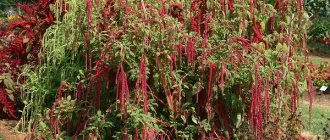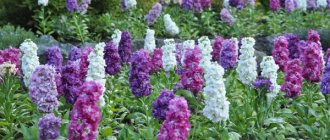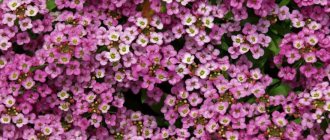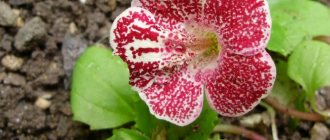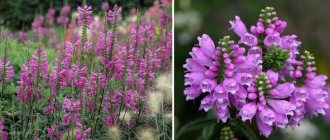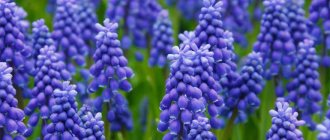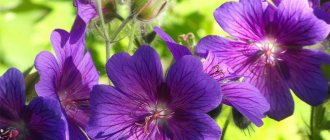Author: Elena N. https://floristics.info/ru/index.php?option=com_contact&view=contact&id=19 Category: Garden plants Published: February 23, 2019Last edits: November 03, 2020
- When to plant
- Growing conditions
- How and when to collect seeds
- Nigella damaceana
plant (lat. Nigella) , or nigella , belongs to the genus of herbaceous plants of the Ranunculaceae family, numbering more than 20 species and widespread in Western Europe, Western Asia and North Africa. The Latin name means approximately the same as the Russian one, since it is derived from the word niger, which means “black”. The nigella flower is called this because of the coal-black seeds of the plant. The spread of Nigella began from Turkey and the North Caucasus, from where it spread first to India, and from there to Europe. The English call nigella kalinji, blessed seeds, flowering fennel, black cumin, black sesame, nutmeg and Italian coriander, although nigella has nothing to do with any of these plants.
Planting and caring for nigella
- Planting: sowing seeds in the ground - in May or before winter, sowing seeds for seedlings - in March-April, transplanting seedlings into the ground - in May.
- Flowering: from June to August-September.
- Lighting: bright sunlight.
- Soil: light, moderately moist calcareous soils.
- Watering: balanced: the plant suffers from both a lack and an excess of moisture.
- Mulching: not recommended.
- Fertilizing: it is advisable to plant the plant in an area that was fertilized with organic matter for the previous crop, and then potassium-phosphorus fertilizing is applied only during flowering.
- Reproduction: by seeds.
- Pests: spider mites or aphids.
- Diseases: powdery mildew.
Read more about growing nigella below.
Nigella: combination with other plants
In the photo you can see beautiful floral ensembles, one of the participants of which is Nigella. No matter how good this flower is in single plantings, its combination with the following plants looks very beautiful and bright, and this is:
- cornflower;
- petunia;
- lobelia;
- gypsophila;
- anemone;
- cornflower;
- verbena.
Incredibly beautiful floral ensembles are obtained if you use transitional colors of the same range, for example, lilac: from the palest to the most saturated. The photo of such a merger amazes with its captured natural beauty.
Botanical description
Nigella nigella is a herbaceous annual with branched stems from 30 to 60 cm high, pinnate and sometimes palmately dissected lacy alternate leaves, the upper of which rise above the flower like an openwork blanket. Nigella flowers are large - up to 4 cm in diameter, bisexual, solitary, with five sepals resembling petals, colored blue, white or yellow.
In flowers of double varieties, the sepals are arranged in two, three or four rows. Nigella petals are transformed into nectaries. The nigella fruit is a flattened or swollen capsule consisting of five leaflets containing matte, ovoid, black nigella seeds.
In decorative floriculture, nigella flowers are an important element of landscape design: they are planted along hedges and borders, in flower beds, in rockeries, on alpine hills, and they are also used as an element of flower arrangements.
- Flower care in November
Application
In the garden
Thanks to its decorative flowers, Damask nigella enjoys the greatest recognition. Naturalistic flower beds, village gardens are the places where Nigella is most beautiful.
Original nigella flowers can be an interesting addition to a variety of flower beds. Of course, for the best visual effect, they should be grown in numerous groups, then they become very expressive.
Photo. Nigella in the garden
Nigella's original but delicate appearance makes it especially impressive next to plants such as:
- poppies;
- cornflowers;
- coreopsis whorled;
- marigold;
- pansies;
- Iberis umbellata;
- geranium.
Nigella looks very beautiful in a flowerbed with low colored perennials, such as periwinkle and sedum. Taller varieties should be planted at the back of the flowerbed for an interesting visual effect. This flower adds lightness and airiness to flower beds. The plant can also be used as a landscaping element in rock gardens. The wealth of varieties allows you to choose options for your garden or balcony in accordance with your preferences.
Thanks to self-sowing, nigella can be a decoration for many years even without our further intervention.
Damask nigella flowers can be successfully cut into a vase; they can decorate an apartment for about a week, and when dried they diversify the winter decor of the garden and apartment.
Nigella can be used to fill empty spaces in flower beds left by early spring blooms.
Charming and original plants, after drying, are used in floristry. The seed pods dry quickly without losing color. They are excellent raw materials used for compositions in dry bouquets.
Growing nigella from seeds
How to sow seeds
Nigella reproduces only by seeds. They can be sown directly into the ground in May or before winter to a depth of about 2 cm. The seedlings of the plant are cold-resistant, but it is better to cover the crops at first. Seedlings tolerate replanting very poorly, so they need to be sown immediately in a permanent place.
Seedling care
For seedlings, nigella seeds are sown in March-April in a greenhouse to a depth of 2 cm. Shoots usually appear by the end of the second or third week. Dive them in the development phase of a pair of true leaves into peat-humus pots, so that the seedlings can be transplanted directly into the flowerbed when the time comes.
Use in the fight against excess weight
It is known that many spices, such as cinnamon, black pepper, ginger, lemon juice, help remove excess water from the body, improve blood flow and cope with appetite.
As we already know, Nigella seeds also help cope with this. Of course, you shouldn’t expect miracles, but by mixing all these spices with the addition of a teaspoon of honey, you can make tea that will help cope with your appetite and remove excess water from the body.
Planting nigella
When to plant
Nigella seedlings are gaining strength very quickly, and in May it will be possible to transplant them into open ground. The place for nigella should be open and sunny, since the plant does not develop well in the shade. By the way, Nigella does not like proximity to ground cover plants, keep this in mind when choosing a site and environment for it. Nigella prefers soils that are loose, dry, light, but nutritious, calcareous or neutral. On acidic soils, as well as in the shade, the plant develops poorly.
How to plant
Nigella seedlings are planted directly in peat-humus pots at a distance of 15-20 cm from each other, the interval between rows is kept at 45-50 cm. With closer planting, you will not achieve lush flowering of nigella or the ripening of its seeds, and you don’t care You will have to thin out too dense thickets. After planting, the area is watered. The soil is not mulched - nigella reacts poorly to mulch. Nigella blooms from seeds approximately 40-45 days after germination, and its flowering lasts about two months.
Requirements for planting site and soil
The climatic conditions of Central Russia and southern Russia meet the requirements of nigella. This is a plant that prefers sunny places with southern exposure. The plant does not like shading.
Nigella is not a demanding plant and will grow in most soils.
It is optimal that the soil for nigella is:
- sufficiently permeable;
- average fertility;
- preferably rich in calcium,
- quite wet.
The following soils are not suitable for the plant:
- sour;
- soaking, swampy;
- too dry.
Before sowing, it is worth checking the pH level of the soil (this can be done, for example, with an acid meter). Nigella damascena grows best in neutral (pH 7) to highly alkaline (pH 11) soil. If the soil in the garden is acidic, you can make it alkaline by liming.
Despite the fact that the plant copes well with drought, it is worth taking care of a fairly moist substrate, but not a wet one.
Good predecessors for nigella are root vegetables and vegetables.
Caring for Nigella in the garden
Growing conditions
Since Nigella does not like mulch, you will have to regularly weed and loosen the area after watering. As for the frequency of watering, Nigella reacts painfully to both excessive and insufficient moisture, so it is necessary to develop a special watering regime for it.
As for feeding, caution is needed in this matter, since it is very easy to overfeed Nigella. You can avoid this if you plant seedlings or sow seeds in an area where predecessors fertilized with organic matter grew, and you don’t have to worry about fertilizers for the first half of the growing season. When nigella blooms, feed it with potassium-phosphorus fertilizer.
- Fieldfare: growing in the garden, types and varieties
Nigella propagation
Nigella reproduces only generatively (by seeds), by seedlings and without seedlings, in spring or before winter. The seed propagation method is described in the previous section. Self-sowing of nigella is also one of the methods of seed propagation. Other methods of propagating nigella are not used in home gardening.
Care
You need to look after the flower very carefully and with love - remove weeds, loosen the soil. But you need to know that Chernushka is afraid of waterlogging, mulching and overfeeding.
Experienced gardeners grow Nigella in the place where the plant grew last year, in a well-fertilized place. During flowering, the flower can be fed with phosphorus-potassium fertilizer once a season.
Pests and diseases
In cool, rainy weather, Nigella may develop powdery mildew. Treating the area with fungicides will help save it, and it is advisable to carry out 2-3 sessions of such treatment with an interval of a week or ten days.
In dry summers, if you neglect your responsibility to water your flowers, Nigella can be attacked by spider mites that feed on the cell sap of the plant's leaves. Spider mites are destroyed with insectoacaricides: Agravertin, Actellik, Akarin, Kleschevit or Fitoverm.
In general, growing nigella does not involve any particular difficulties with either diseases or pests, since it is a fairly resistant plant, especially since the spicy aroma of its seeds successfully repels insects.
Reviews from gardeners
Alexandrovna, Krasnodar
I have been sown Nigella Damascus by self-sowing for several years now, and it sprouts like a weed in the fall, and in our climate it does not freeze.
Source: www.forumhouse.ru
Rudova Elena, Moscow
She planted Nigella in the sun, in fertile soil. This time it grew much larger and bloomed for a long time. She even self-seeded.
Source: www.forumhouse.ru
Nigella after flowering
How and when to collect seeds
Nigella seeds begin to be collected when about two-thirds of the seed pods are ripe, and this most often happens at the end of August or September. Stems with ripe bolls are cut, tied into bunches and laid to dry in a dry room with good ventilation. Seeds are obtained very easily from dried pods. Nigella seeds remain viable for about two years. You can immediately sow them in a flowerbed before winter, or you can wait until spring.
Use in cosmetology
In cosmetology it is used in powder form. For problematic facial skin - acne, peeling, unclear facial contour, use the following recipe.
Nigella seed powder, mixed with warm water to a mushy state, is applied to the face and collar area and left until completely dry. If your skin type is dry, then add a few drops of essential or vegetable oil. After the procedure, rinse off the composition with warm water.
For postpartum stretch marks, add chernukha powder to massage oil, rub into the skin of the abdomen and legs and leave for 30 minutes. To strengthen the nail plate, add to liquid soap.
Types and varieties
Nigella damaceana
The most commonly grown species in our gardens is Nigella damaceana, or “lady in green,” an unpretentious ornamental plant that has beautiful not only flowers, but also leaves. The homeland of Nigella Damascus is Asia Minor and Western Asia, the Caucasus, Crimea and the Mediterranean. The height of the branched stems reaches from 30 to 50 cm. The leaves are twice or thrice pinnately dissected, simple or double flowers of white, light blue or dark blue are surrounded by a peculiar lace blanket of openwork leaves located on the stem directly under the flower.
There are many varieties of Nigella Damascus, but be careful when choosing: a variety such as Baby Blue, for example, causes more bewilderment than admiration: some kind of lump of greenery no higher than 15 cm with microscopic flowers and ugly horned fruits. We offer you varieties of Nigella Damascus that will not disappoint you:
- Cletra: growing in open ground, types
- Cambridge Blue - a form with delicate shoots up to 90 cm tall with blue semi-double flowers;
- Miss Jekyll Rose is a form with straight, arrow-like shoots up to 50 cm high with dark red-pink flowers. The variety was bred specifically for florists who use it to create flower arrangements - dry or fresh;
- Persian Jewels - a mixture of varieties with flowers of white, blue, pink and mauve;
- Dwarf Moody Blue is a dwarf variety 15-20 cm high with blue flowers.
Nigella sativa
As a medicinal plant, Nigella sativa is grown in cultivation - an annual plant from 30 to 70 cm in height with simple and double flowers of blue, white or greenish-yellow hue, which stand out brightly against the background of lacy finely dissected leaves, similar to fennel foliage. Nigella sativa is famous for its black seeds with a strong spicy aroma, which have been used for many centuries as a flavoring agent for various dishes, as well as a stomachic and choleretic agent.
It is this plant that is called black sesame, black cumin, flowering fennel, and it is about this plant that the Koran says: “In black cumin there is healing from all diseases.”
Spanish Nigella (Nigella hispanica)
Slightly less known in culture is Nigella spanisha, also an annual plant from southern Spain and northern Africa, up to 60 cm high, with deeply divided dark green leaves and dark blue flowers up to 6 cm in diameter with bright stamens and a faint aroma. The reddish ovaries of Nigella spanisha also attract attention. This species blooms from June to September.
Nigella orientalis
Sometimes in cultivation, Nigella orientalis, an annual with small flowers and decorative fruits, is grown to decorate flower beds, cut flowers and make dry bouquets.
German legend
There is a German legend about Emperor Frederick I. During the campaign to the Holy Land, the army made a halt near the lake. While walking, Friedrich heard singing from the side of the pond, and looking closer he saw a beautiful nymph who called him.
After he entered the water and approached the maiden in a blue robe and a beautiful face, no one saw him again. At the place of the disappearance, a beautiful flower was found, reminiscent of that same nymph - a thin green figure in a blue robe.
There is another fun fact. Nigella arvensis, translated from German means “get lost.” Girls give it to guys they don't want to date.
Properties of nigella
Nigella sativum, or Nigella medicinal, is popular not only as an ornamental plant. Its seeds, which have a spicy peppery taste and strawberry aroma, are used in cooking as a spice: crushed, added to soups, baked with it, and added to marinades when canning vegetables. Nigella leaves, which have a tonic and general strengthening effect, are also used as greens. They are added to salads in the summer along with basil, coriander, parsley, dill and chervil.
In addition to taste, nigella has high value and beneficial properties. The seeds of the plant, containing vitamin E, carotene, ascorbic acid, essential oils and the enzyme lipase, have a diuretic, laxative, analgesic, antispasmodic, antiulcer, antifungal, antibacterial, antioxidant, antiallergenic, bronchodilator, antitumor, antiviral, immunostimulating, anthelmintic and choleretic effect.
They are used for gastrointestinal disorders and flatulence, high blood pressure, hormonal disorders, dysbacteriosis, vegetative-vascular dystonia, periodontal disease, cystitis, pyelonephritis, loss of appetite, they have a beneficial effect on the functioning of the pancreas and liver, help slow down the aging process, strengthen memory .
Nigella seeds are used simultaneously with medications to treat the following diseases: epilepsy, diabetes, asthma, arterial hypertension, cancer, as well as drug addiction. Tea made from nigella seeds speeds up metabolism, stimulates the body's natural cleansing of waste and toxins, and also promotes weight loss.
We offer you recipes for drugs that you can make yourself at home:
- tincture of nigella seeds: one part of nigella seeds is infused in a dark place for a week in five parts of vodka, then the liquid is filtered and put in the refrigerator. Take 10-15 drops for diseases of the respiratory tract.
- Nigella tea: pour 1 g of seeds with a glass of boiling water and leave for a quarter of an hour. Drink during the day in several doses as a diuretic, laxative, choleretic and tonic. To achieve an anthelmintic effect, you should drink at least two liters of this tea a day along with eating spicy food - onions, herring. The advantage of nigella seeds is that, although they are as hot as black pepper, they do not irritate the mucous membrane of the intestines and stomach.
Here’s a simple recipe for delicious cakes with nigella seeds: knead the dough from a kilogram of flour in water, add one and a half spoons of nigella seeds to it and let the dough sit for 40-50 minutes, then divide it into socs, roll them out into cakes and bake in the oven, then grease with hot oil.
Nigella can be successfully used to fight moths, like lavender. Sew nigella seeds into small fabric or gauze bags and place them on shelves in the closet: the aroma of the seeds will repel moths. Mosquitoes and even snakes are afraid of this smell.
However, despite the beneficial properties of nigella, it is forbidden to use its seeds and preparations from the plant for pregnant women, especially in later stages, suffering from coronary heart disease, active thrombophlebitis, acute gastritis with high acidity, cholelithiasis, as well as people with organ transplants, because an increased immune system may cause transplant organ rejection.
Use in medicine
In allopathic medicine, oil from the seeds is used, and in folk medicine, in powder form, both separately and in combination with other medicinal herbs - thyme, calendula, chamomile, oregano. Possesses:
- immunomodulatory effect;
- diuretic effect, used in the treatment of pyelonephritis, cystitis, used for kidney diseases;
- antispasmodic properties for diseases of the digestive tract;
- anti-inflammatory effect for gum disease;
- auxiliary action for the treatment of diseases of the upper respiratory tract;
- medicinal properties for hypertension;
- antiparasitic effect;
- hypoglycemic effect in patients with diabetes mellitus;
- analgesic properties for headaches;
- choleretic properties;
- therapeutic effect for skin diseases.
In the East there is a saying that “nigella cures all diseases, but death is beyond its control.”
